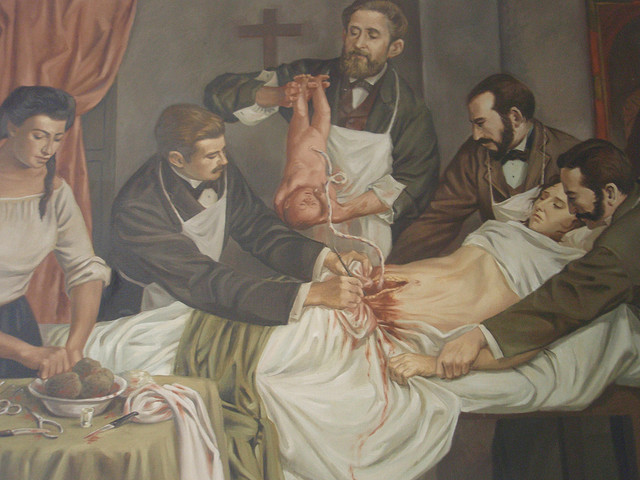
A week ago, I found out that the baby I’m carrying is breech. Instead of being head down, she is stubbornly head up, not such a good position for birthing. Since I am only a few weeks away from my due date, it’s unlikely she’ll flip on her own. And if she stays breech, I’ll likely have to have a C-section.
So yesterday morning I went to the hospital to have a doctor try and manhandle her into the correct position, a procedure called external cephalic version (or “version” for short). It’s a fancy name for a rather brutish procedure: A doctor clasps the baby’s head, a nurse grabs the baby’s butt, and then they try to thrust her into the right position. This works about half the time. And there are risks: The baby’s heart rate can fall, the umbilical cord can get squeezed, the placenta can tear, the amniotic sac can rupture. Once in a great while the doctor has to take the baby out right away.
The risk of a version leading to an emergency C-section is vanishingly small, about 0.5%. But because there is some risk, the hospital takes all sorts of precautions. For example, the nurse told me not to eat or drink anything after midnight. My appointment wasn’t until 8:30am. “Even water?!” I asked. Yes, even water.
There’s a reason for this seemingly Draconian rule. Very rarely people under anesthesia will vomit and  aspirate the contents of their stomach into their lungs, which can lead to a severe case of pneumonia. When I showed up for my appointment yesterday morning, the “no eating or drinking” directive made sense. By 1pm, I wanted a fucking donut, and the rule seemed asinine.
aspirate the contents of their stomach into their lungs, which can lead to a severe case of pneumonia. When I showed up for my appointment yesterday morning, the “no eating or drinking” directive made sense. By 1pm, I wanted a fucking donut, and the rule seemed asinine.
Now, hours later, my belly is full. But the rule still seems silly. Let’s run the numbers. There is a 0.5% chance that a woman undergoing a version will need an emergency C-section. But most emergency C-sections involve local anesthesia, and aspiration is typically only a risk for general anesthesia. According to a 2005 study, between 15 and 30% of women who have emergency C-sections have general anesthesia. (That number is probably even lower today.) The risk of aspiration during a Cesarean is 0.06%. And not all cases of aspiration are dangerous. Some don’t require any treatment at all.
So let’s say we have a million women getting versions. About 5,000 will need emergency C-sections. Of those, perhaps 1,500 will receive general anesthesia. And, here’s where things get ridiculous, roughly one of those women will aspirate. And the chances that she’ll develop aspiration-related pneumonia are even slimmer.
Of course, there’s no doubt debate about the exact odds of each of these events, but you get my drift, right? It’s terrifically unlikely that I’m going to develop pneumonia because I had a smoothie before my version appointment.
Think about what would happen if we applied this kind of risk aversion to other realms? I would never eat anything for fear that I would leave the house, be struck by a car (or bus, or piano, or tree limb, or stray bullet) and need emergency surgery.
In the grand scheme of things, forgoing food and water for half a day isn’t that big of a deal. No one has died of starvation or thirst in a matter of hours. But I’m not the kind of person who skips meals or forgets to eat. I like food. I get shaky and angry when I’m deprived. So forcing me to sit in a hospital bed for five hours without sustenance (when all I want to do is wolf down the croissant that my husband is saving for after the procedure) seems cruel and unusual, not to mention counterproductive. I’m already in the hospital. Shouldn’t the staff be working to reduce my anxiety?
In the end, all that fasting was for naught. The obstetricians were so busy attending to real emergencies that they never had a chance to do my version. At 1pm they sent me home. So once again I am fasting in preparation for another trip to the hospital. Although I think the rule is pointless, I can’t bring myself to break it. What if they do the ultrasound and see not just a baby, but also a cherry scone? Would they send me home yet again? I’m not willing to risk it.
* * * *
Top image via daruis norvilas on Flickr
Second image via vnysia on Flickr
I bet if more women knew these numbers, a whole lot more of us would sneak snacks into the delivery room. Most hospitals won’t let you eat during labor because of these same risks. What they don’t tell you is that it is training for when the baby is actually here and you can’t seem to make time to eat for yourself!
Interesting numbers. When I had a procedure scheduled, I too was told the fears of aspiration under sedation. My appointment was at 3pm. I was starving! As my husband had a Mountain Dew while waiting. I promptly had an Italian beef, cheese fries, a Diet Coke, a bottle or 3 of water, and a cookie afterwards. I then felt the agonizing pain of overeating and a food coma. At least now we know you are more likely to starve to death than aspirate if you have some water beforehand. Love your stories, I hope your little girl righted herself. Hugs!